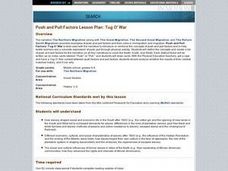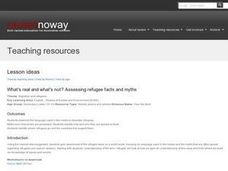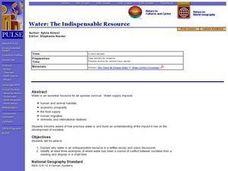Big History Project
Human Migration Patterns II
While humans have always been on the move, the period between 1400 and 1800 saw vast migrations of people between the East and the West. These migrations—whether through slavery or a desire to colonize new lands—shaped the modern world....
Curated OER
Migration
Students investigate migration issues. In this global studies lesson, students examine photographs that feature migrants from Canary Island and their movement to Spain by smugglers. Students view a PowerPoint presentation and discuss how...
Advocates for Human Rights
Who are Immigrants?
What do Jerry Yang, Patrick Ewing, John Muir, Charlize Theron, Peter Jennings, and Saint Frances X Cabrini all have in common? They are all immigrants to the United States. Famous and not-so-famous immigrants are the focus of a resource...
Constitutional Rights Foundation
Educating About Immigration The DREAM Act
Group members role play state legislators, supporters of and opponents to the The DREAM Act (Development, Relief, and Education for Alien Minors). After listening to the arguments put forth for and against the immigration legislation,...
Stanford University
Chicago Race Riots of 1919
Students explore the Chicago Race Riots of 1919. In this American history lesson, students watch the move "Up South" regarding the African American migration following World War I. Students read primary documents regarding the race riots...
Curated OER
Get Ready to Hibernate! Migrate! or Get Fat!
Young scholars explore the different ways which animals survive the winter months, and sort animals into correct categories using a Venn diagram.
Curated OER
Children Leaving Cuba
First graders explore migration from Cuba to the United States. They explain reasons why people migrate to different places. Through guest speakers and discussion groups, 1st graders compare and contrast the experiences of Cuban families...
Curated OER
Social Studies: Chinese Migration to America
Students examine human migrations and hypothesize why Chinese immigrants came to the Pacific Northwest. In groups, they research reasons for the migration and record them on a Venn Diagram with general migratory reasons. Students...
Curated OER
The People of Kansas: Where did they come from and why did they come?
Students develop and understanding of emigration and the reasons for emigration. They use census data to study the migration of people to Kansas.
Curated OER
Contemporary Mexican and Puerto Rican Immigration
Students in an ESL classroom compare and contrast Puetro Rican and Mexican cultures. In groups, they research the reasons why people leave one country for another and how to obtain a visa. As a class, they brainstorm a list of the...
World Wildlife Fund
Land of the Midnight Sun
From days of 24 hour sunlight, to endless nights that last for days, the Arctic is a very unique place to live. Examine the seasonal changes that occur in the northern-most reaches of the globe and the impact they have on the plants and...
Learning to Give
Humphrey The Lost Whale
The children's book Humphrey the Lost Whale tells an amazing tale of a community joining together for a common cause. Read this book with your class, making connections between the events in the story and personal experiences of young...
Curated OER
The Study of the Spanish-Speaking People of Texas: Immigration
Students identify the meaning of the following terms: immigrant, immigration, migrate, and assimilation. They identify reasons that immigrant groups came to Texas and explain where groups settle and the influence these groups have on...
Howard Hughes Medical Institute
Zebrafish and Skin Color
You may not know if that zebrafish in your fish tank is a model citizen—but it is definitely a model organism! What can we learn about ourselves from a tiny zebrafish? Discover more about the polygenic trait of skin color through a...
Curated OER
Migration and Refugees
Students explore issues relating to refugees. Using the internet, they gather facts about refugees. Students discuss the range of situations which turn citizens of one country into refugees of another.
Curated OER
Get Ready, Get Set, Hibernate
Students match each body part or idea from a work bank about methods of animal adaptations for winter survival. They observe as the first one, food is covered with the whole class before completing the rest of the diagram. They discuss...
Curated OER
Push and Pull Factors: Tug O' War
Pupils analyze the factors that led to migration in the 19th century including the forces that drew people to resettle as well as to return a place where they previously lived.
Channel Islands Film
Once Upon A Time (Saxipak’a): Lesson Plan 1
As part of a study of the history of the Chumash on California's Channel Island chain, class members view the documentary Once Upon a Time, respond to discussion questions, and create a timeline for the different waves of migration.
Curated OER
What's Real And What's Not? Assessing Refugee Facts And Myths
Students examine language used in media to describe refugees, and identify how and why myths and misnomers are spread as facts.
Students then identify where refugees go and countries that support them.
Curated OER
World Geography: Water: The Indispensable Resource
Young scholars are able to explain why water is an indispensable resource in a written essay and class discussion. They identify at least three examples of where water has been a source of conflict between societies from a reading and...
Curated OER
Land Bridge Theory
Fifth graders observe a map that includes where the land bridge was located and that its name was Beringia and look in the Social Studies books to read about the Land Bridge Theory. The class then brainstorms reasons why they think...
Curated OER
2.0 "Water Is Life" Global Water Awareness Mini-Unit (Grades3-5)
Young scholars study the amount of potable water on the Earth. For this water lesson, students examine the amount of potable water as compared to all the water on the Earth. They discuss why many parts of the world do not have access to...
Curated OER
ESL Activities: Our Paths to Australia - 15 September 2004
Pupils identify their own feelings about coming to a new country. Students understand vocabulary associated with emotions. Pupils recognise that their emotions are not unusual amongst people with similar experiences .
Curated OER
Mapping the Human Movement
Students research data on African-American emigration, place the data in a chart and create a human movement map. They also create another map using research on current immigration information.

























